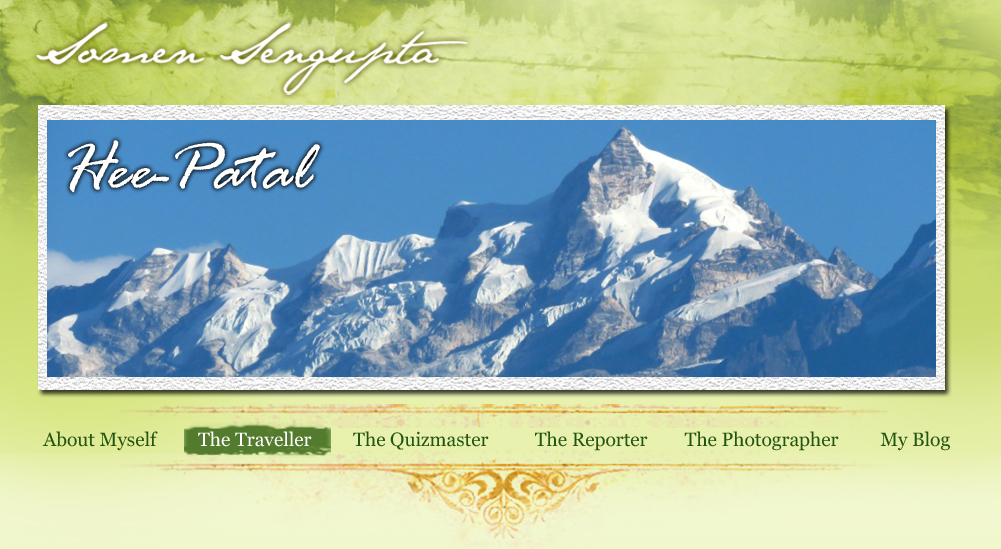| ENCOUNTERING RHODODENDRONS AND KANCHENJUNGHA. |
|
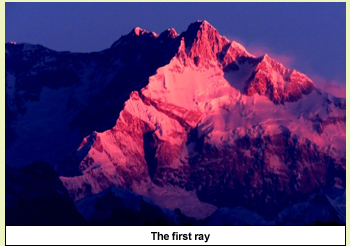 The altercation with the young cab driver was pointless and it was not that late when I realized it.
The altercation with the young cab driver was pointless and it was not that late when I realized it.
I hired the cab from Biksthang of West Sikkim to scale up some more height to reach a small village named Hee. Little did I know that there are three places all have the prefix Hee before them. One is Hee Barmiok, one is Hee Bazaar and another one is Hee-Patal where I wanted to go.
I soon asked him the most common question every time I ask before getting closer to the giant.
Have you seen Kanchenjungha in last few days? Did it offer presence over the horizon yesterday atleast?
What is great for me is not great for one who drives a taxi in west Sikkim - So a perplexing reply came in most insipid way. “It may be - I did not notice much - December is not the right time to see Kanchenjungha. You must come in September to Novemeber.”
My heart bleeds whenever I fail to catch the majestic range from any probable point. She counts this as a demerit and game to that.
The landscape outside grabbed my imagination again. It is a time to change here in Sikkim. As the year comes to end beauty of the nature evolves with an unimaginable richness of bio diversity. Sadly this face of nature is still mostly unseen and more pity is people's ignorance about Sikkim - the land of blooming rhododendrons.
When I reached my resort it was 12 noon. The ever smiling resort owner welcomed with a proposal to go for a trek of 5 km in jungle.. “Sir, are you fit enough to do a trek of 5 km upscale ?
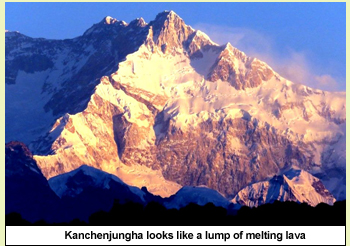 ” 5 km upscale trekking! ” 5 km upscale trekking!
I gladly surrendered but not before knowing his idea.
A 40 minutes drive from here will take us to Hillery, from where another 5 km trek will take us to Barsai Rhododendron Sanctuary.
Barsai!
The name rang a bell in my mind. “Oh yes - the world of rhododendron!” - I exclaimed. Out of 1000 or so known varieties of rhododendrons nearly 600 types are found in Sikkim and most of those grow naturally in Barsai. “Wet and cold climate of west Sikkim is ideal for blooming rhododendrons. Look here near my resort there are many and they grow without any care from us,” - resort owner kept on talking.
I promptly took a look around to find that on the lap of green a red bunch of rhododendron were blooming like a burning flame. “What is the name of that gentleman who came here in 1848 from Glasgow?” I asked my wife once more.
“Joseph Dalton Hooker and this is perhaps 10th time I am helping you to recollect the name.” She was vexed.
Yes - now I recall everything about the man. Joseph Dalton Hooker took his MD degree in 1839 and thanks to his passion of botanical expedition he landed here in Sikkim in 1848. By braving unimaginable hardships, the man collected an amazing amount of information on rhododendrons, ferns and orchids. His book titled Rhododendron of Sikkim published in 1849 is still counted as a bible in knowing flora of Sikkim.
Soon a deadly feeling of chill engulfed the air. Though our warm jackets were on, we were shivering badly. We settled in a wooden cottage with warm bed and a balcony facing the mountain.
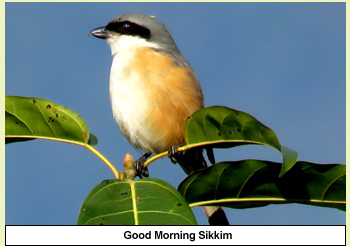 Soon the resort owner mentioned that I was waiting to hear. “Sir - if you are lucky, tomorrow you will see Kanchenjungha from the best seat of nature's theatre”. Soon the resort owner mentioned that I was waiting to hear. “Sir - if you are lucky, tomorrow you will see Kanchenjungha from the best seat of nature's theatre”.
If luck permits!
This is the bone rattling sentence that overcasts my imagination everytime I am in Sikkim or Darjeeling. Every time before going to bed at night I looked up at the sky to scale how cloudless it is. Everytime I badly look for a real ‘good’ morning..
A middle aged man came up to me and said, “What about a small walk in village ?” The vilage he was referring to is one of the smallest village of Sikkim with only 89 houses. There are hardly 500 odd people living here. I joined him and found him to be knowledgeable enough on the biodiversity of Himalaya. He tried his best to keep me updated with every single unknown flower or birds that came on our way. Very near to this place there is a forest named Samdong - Believe it or not it is the home of 65 species of rare Himalayan birds. This was an opportunity for me to capture them for posterity in my camera. Nothing extra ordinary happened on that evening except the blow of terrific cold wind blowing through the deep forests.
Someone knocked my door the next day at dawn when it was still little dark outside. “Come sir,” the man called and I had my reason of rejoice.
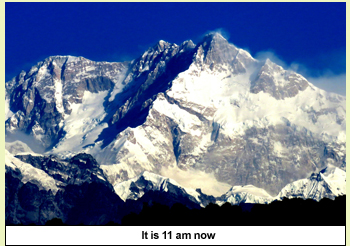 Will I finally get to see Kanchenjungha ? Am I so near to that gigantic peak ? Overcoming every single doubt I tried to place my best possible vision before me and realised as it seems then that now between me and Kanchenjungha there is no one. Will I finally get to see Kanchenjungha ? Am I so near to that gigantic peak ? Overcoming every single doubt I tried to place my best possible vision before me and realised as it seems then that now between me and Kanchenjungha there is no one.
The clarity and proximity was amazing - it was as if I extended my arm, I would be able to touch the peak. At dawn, a little after 5 am, the peak is flooded with light - it was as if lava was spweing from an active volcano.
It soon turned golden as the first ray of sunshine from the rising Sun fell on it. Within 15 minutes the colour changed to a light shade of yellow and pink. Every colour lasted for a few minutes only.
As soon as Sun fully went up in the sky, Kanchenjungha turned brighter - it was sparkling like raw gold coming out of fire. This was the moment I had been waiting for years. Every experience of watching Kanchenjungha is distinctive and here from Hee-Patal is it exceptionally special. The brightness of the rock bed was so flamboyant that even by naked eyes one could see glaciers and other details of the peak. The most surprising was the vivid details of central peak of Kanchenjungha. I stood transfixed.
With each passing minute, the peak changed. By noon when I was about to rush to the airport the snow was in its original color that is milky white. Like always parting time with Kanchenjungha is a moment of tragedy to me. Many a time it has reduced me to tears as well.
Such is my connection with this gigantic peak.
Travel Logistics ;
# Hee-Patal is a very small village in West Sikkim.
# It 151 km from NJP station and 143 km from Bagdogra airport both are in Bengal.
# It takes 4 hours plus in car.
# Night stay is needed as the place is too far from any big town.
# Do not expect much luxury – Some good hotels are.
# Hotel . food and transport – All are little expensive here.
# It is one of the best bird watching place of India.
Useful website www.sikkimtourism.gov.in
This article was published in The Hitavada on 18th November 2018.
Click here to view the original article
|
